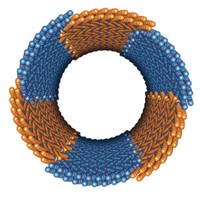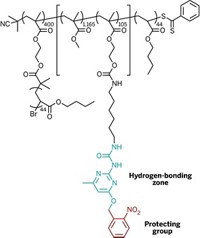Advertisement
Grab your lab coat. Let's get started
Welcome!
Welcome!
Create an account below to get 6 C&EN articles per month, receive newsletters and more - all free.
It seems this is your first time logging in online. Please enter the following information to continue.
As an ACS member you automatically get access to this site. All we need is few more details to create your reading experience.
Not you? Sign in with a different account.
Not you? Sign in with a different account.
ERROR 1
ERROR 1
ERROR 2
ERROR 2
ERROR 2
ERROR 2
ERROR 2
Password and Confirm password must match.
If you have an ACS member number, please enter it here so we can link this account to your membership. (optional)
ERROR 2
ACS values your privacy. By submitting your information, you are gaining access to C&EN and subscribing to our weekly newsletter. We use the information you provide to make your reading experience better, and we will never sell your data to third party members.
Materials
Two-Faced Dendrimers Form Onionlike Vesicles
Controllable bilayer and multilayer dendrimersomes could be useful for drug delivery
by Stu Borman
June 23, 2014
| A version of this story appeared in
Volume 92, Issue 25
Researchers have discovered six new Janus dendrimers that self-assemble into uniform onionlike vesicles with predictable dimensions and a controllable number of internal bilayers (Proc. Natl. Acad. Sci. USA 2014, DOI: 10.1073/pnas.1402858111). They envision the vesicles, dubbed dendrimersomes, being used for drug delivery one day: Each layer could be loaded with various types or doses of drugs that get released over time by enzymatic cleavage of bonds in bilayers or other cleavage mechanisms. Janus dendrimers, discovered by Virgil Percec of the University of Pennsylvania and coworkers a few years ago, are molecules that branch out repetitively from a point and, like the Roman god Janus, have two faces. They are amphiphilic—polar on one face and nonpolar on the other (Science 2010, DOI: 10.1126/science.1185547). Percec’s group identified the new Janus dendrimers during a molecular library search. The number of bilayers formed in the dendrimersomes depends on the concentration of the dendrimer starting material used to make them. Multibilayer vesicles made previously by other means required “very complex and time-consuming methods that do not control their size and size distribution in a precise way,” the researchers note, adding that the new approach overcomes those limitations.





Join the conversation
Contact the reporter
Submit a Letter to the Editor for publication
Engage with us on Twitter